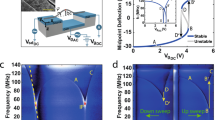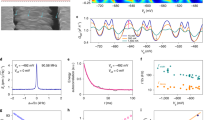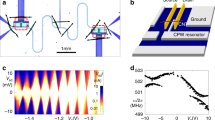Abstract
Nanoelectromechanical systems (NEMS) hold promise for a number of scientific and technological applications. In particular, NEMS oscillators have been proposed for use in ultrasensitive mass detection1,2, radio-frequency signal processing3,4, and as a model system for exploring quantum phenomena in macroscopic systems5,6. Perhaps the ultimate material for these applications is a carbon nanotube. They are the stiffest material known, have low density, ultrasmall cross-sections and can be defect-free. Equally important, a nanotube can act as a transistor7 and thus may be able to sense its own motion. In spite of this great promise, a room-temperature, self-detecting nanotube oscillator has not been realized, although some progress has been made8,9,10,11,12. Here we report the electrical actuation and detection of the guitar-string-like oscillation modes of doubly clamped nanotube oscillators. We show that the resonance frequency can be widely tuned and that the devices can be used to transduce very small forces.
This is a preview of subscription content, access via your institution
Access options
Subscribe to this journal
Receive 51 print issues and online access
$199.00 per year
only $3.90 per issue
Buy this article
- Purchase on Springer Link
- Instant access to full article PDF
Prices may be subject to local taxes which are calculated during checkout



Similar content being viewed by others
References
Sidles, J. A. et al. Magnetic-resonance force microscopy. Rev. Mod. Phys. 67, 249–265 (1995)
Roukes, M. Plenty of room indeed. Sci. Am. 285, 48–57 (2001)
Nguyen, C. T. C. Frequency-selective MEMS for miniaturized low-power communication devices. IEEE Trans. Microwave Theory Tech. 47, 1486–1503 (1999)
Nguyen, C. T. C., Wong, A.-C. & Hao, D. Solid-State Circuits Conf. 78–79, 1999 (Digest of Technical Papers, ISSCC, IEEE International, San Francisco, California, 1999)
Cho, A. Physics—Researchers race to put the quantum into mechanics. Science 299, 36–37 (2003)
LaHaye, M. D., Buu, O., Camarota, B. & Schwab, K. C. Approaching the quantum limit of a nanomechanical resonator. Science 304, 74–77 (2004)
Dresselhaus, M. S., Dresselhaus, G. & Avouris, P. Carbon Nanotubes (Springer, Berlin, 2001)
Poncharal, P., Wang, Z. L., Ugarte, D. & de Heer, W. A. Electrostatic deflections and electromechanical resonances of carbon nanotubes. Science 283, 1513–1516 (1999)
Gao, R. P. et al. Nanomechanics of individual carbon nanotubes from pyrolytically grown arrays. Phys. Rev. Lett. 85, 622–625 (2000)
Reulet, B. et al. Acoustoelectric effects in carbon nanotubes. Phys. Rev. Lett. 85, 2829–2832 (2000)
Purcell, S. T., Vincent, P., Journet, C. & Binh, V. T. Tuning of nanotube mechanical resonances by electric field pulling. Phys. Rev. Lett. 89, 276103 (2002)
Babic, B., Furer, J., Sahoo, S., Farhangfar, S. & Schonenberger, C. Intrinsic thermal vibrations of suspended doubly clamped single-wall carbon nanotubes. Nano Lett. 3, 1577–1580 (2003)
Minot, E. D. et al. Tuning carbon nanotube band gaps with strain. Phys. Rev. Lett. 90, 156401 (2003)
Kong, J., Soh, H. T., Cassell, A. M., Quate, C. F. & Dai, H. J. Synthesis of individual single-walled carbon nanotubes on patterned silicon wafers. Nature 395, 878–881 (1998)
Hertel, T., Walkup, R. E. & Avouris, P. Deformation of carbon nanotubes by surface van der Waals forces. Phys. Rev. B 58, 13870–13873 (1998)
Tans, S. J., Verschueren, A. R. M. & Dekker, C. Room-temperature transistor based on a single carbon nanotube. Nature 393, 49–52 (1998)
Zhou, C. W., Kong, J. & Dai, H. J. Intrinsic electrical properties of individual single-walled carbon nanotubes with small band gaps. Phys. Rev. Lett. 84, 5604–5607 (2000)
Minot, E. D., Yaish, Y., Sazonova, V. & McEuen, P. L. Determination of electron orbital magnetic moments in carbon nanotubes. Nature 428, 536–539 (2004)
Knobel, R. G. & Cleland, A. N. Nanometre-scale displacement sensing using a single electron transistor. Nature 424, 291–293 (2003)
Brenner, D. W. Empirical potential for hydrocarbons for use in simulating the chemical vapor-deposition of diamond films. Phys. Rev. B 42, 9458–9471 (1990)
Sapmaz, S., Blanter, Y. M., Gurevich, L. & van der Zant, H. S. J. Carbon nanotubes as nanoelectromechanical systems. Phys. Rev. B 67, 235414 (2003)
Yurke, B., Greywall, D. S., Pargellis, A. N. & Busch, P. A. Theory of amplifier-noise evasion in an oscillator employing a nonlinear resonator. Phys. Rev. A. 51, 4211–4229 (1995)
Bhiladvala, R. B. & Wang, Z. J. Effect of fluids on the Q-factors and resonance frequency of oscillating beams. Phys. Rev. E 69, 036307 (2004)
Jenkins, N. E. et al. Batch fabrication and characterization of ultrasensitive cantilevers with submicron magnetic tips. J. Vac. Sci. Technol. B 22, 909–915 (2004)
Stowe, T. D. et al. Attonewton force detection using ultrathin silicon cantilevers. Appl. Phys. Lett. 71, 288–290 (1997)
Mohanty, P., Harrington, D. A. & Roukes, M. L. Measurement of small forces in micron-sized resonators. Physica B 284, 2143–2144 (2000)
Stipe, B. C., Mamin, H. J., Stowe, T. D., Kenny, T. W. & Rugar, D. Magnetic dissipation and fluctuations in individual nanomagnets measured by ultrasensitive cantilever magnetometry. Phys. Rev. Lett. 86, 2874–2877 (2001)
Mamin, H. J. & Rugar, D. Sub-attonewton force detection at millikelvin temperatures. Appl. Phys. Lett. 79, 3358–3360 (2001)
Acknowledgements
We thank E. Minot for discussions. This work was supported by the NSF through the Cornell Center for Materials Research and the NIRT program, and by the MARCO Focused Research Center on Materials, Structures, and Devices. Sample fabrication was performed at the Cornell Nano-Scale Science and Technology Facility (a member of the National Nanofabrication Infrastructure Network), funded by the NSF.
Author information
Authors and Affiliations
Corresponding author
Ethics declarations
Competing interests
The authors declare that they have no competing financial interests.
Rights and permissions
About this article
Cite this article
Sazonova, V., Yaish, Y., Üstünel, H. et al. A tunable carbon nanotube electromechanical oscillator. Nature 431, 284–287 (2004). https://doi.org/10.1038/nature02905
Received:
Accepted:
Issue Date:
DOI: https://doi.org/10.1038/nature02905
This article is cited by
-
Graphene nanomechanical vibrations measured with a phase-coherent software-defined radio
Communications Engineering (2024)
-
Numerical Simulation and Optimization of Stable Coaxial Jet Formation and Direct-Write Printing Array Nanoarchitectonics
Journal of Electronic Materials (2024)
-
On the importance of modified continuum mechanics to predict the vibration of an embedded nanosphere in fluid
Zeitschrift für angewandte Mathematik und Physik (2024)
-
Extreme mechanical tunability in suspended MoS2 resonator controlled by Joule heating
npj 2D Materials and Applications (2023)
-
Theoretical modelling of arch-shaped carbon nanotube resonators exhibiting Euler–Bernoulli snap-through bi-stability
Nonlinear Dynamics (2023)
Comments
By submitting a comment you agree to abide by our Terms and Community Guidelines. If you find something abusive or that does not comply with our terms or guidelines please flag it as inappropriate.



